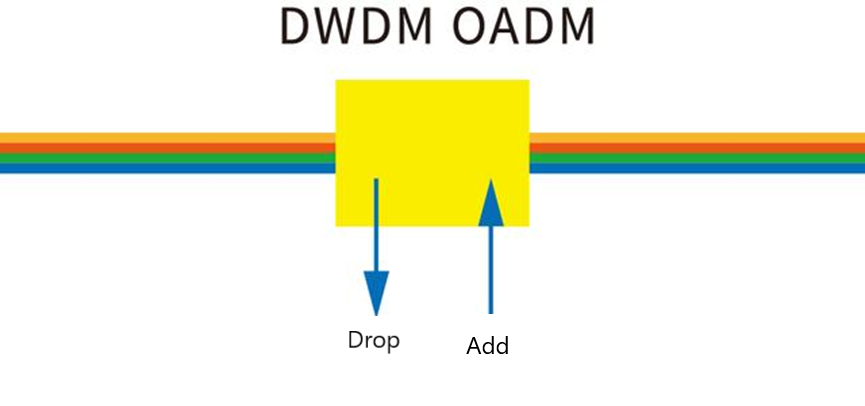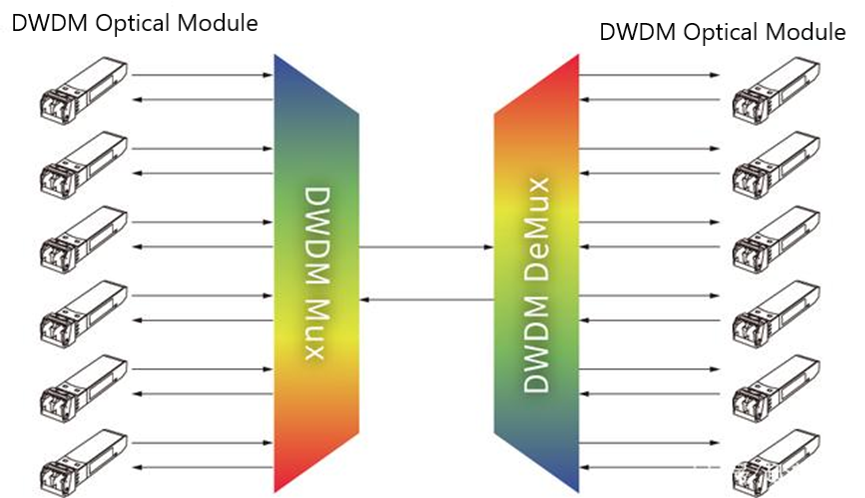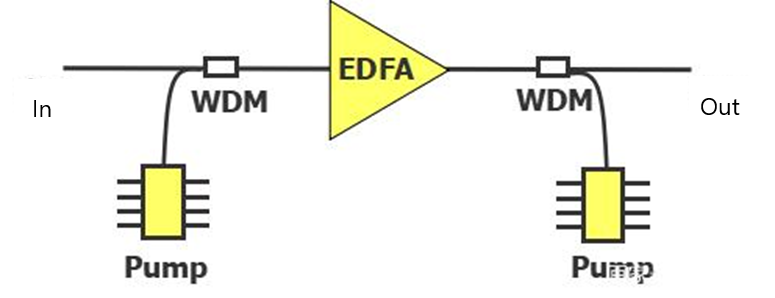Dense Wavelength Division Multiplexing (DWDM) is the ability to combine a set of optical wavelengths for transmission over a single fibre. DWDM technology is an extension of optical networks and the main advantage of DWDM is that it is protocol and transmission rate independent, allowing DWDM-based networks to transmit data over IP, ATM, SONET, SDH and Ethernet.
DWDM systems typically have the following optical components: DWDM optical modules,
DWDM MUX/DEMUX, DWDM OADM and optical amplifiers.
DWDM Optical Modules
As a class of optical module, DWDM optical module is an important device for photoelectric signal conversion, just like ordinary optical module, DWMD optical module needs DWDM wavelength division multiplexer to cooperate with the application, the corresponding wavelength band through the combined wave splitting in a core or a pair of optical fiber to achieve large capacity long-distance communication transmission. Each DWDM optical module has its own specific wavelength, using DWDM technology, can greatly save fiber resources, while ordinary optical modules can not. Most of the DWDM optical modules on the market today work at 100 GHz and 50 GHz (DWDM SFP, DWDM SFP+, DWDM XFP, etc.).
DWDM MUX/DEMUX
A DWDM multiplexer (Mux) combines the output optical signals from multiple transmitters for transmission over a single fibre. At the receiving end, another DWDM demultiplexer (Demux) separates the combined optical signals. only one fibre is used between DWDM multiplexers (in each transmission direction). instead of using a single fibre in each pair of optical modules, DWDM allows multiple optical channels to occupy a single optical cable.
AAWG
AAWG is a type of DWDM multiplexer. The first commercially available DWDM multiplexers in fibre optic communication systems consisted of multiple three-port dielectric film filters (TFF) in series, but when the number of channels was greater than 16, DWDM modules based on TFF technology were too lossy to meet the application requirements. A typical DWDM system, however, typically carries more than 40 or 48 wavelengths in a single fibre and therefore requires a larger number of ports for multiplexing/demultiplexing. WDM modules in series configurations accumulate too much power loss at the back ports, so parallel configurations are needed to multiplex/demultiplex dozens of wavelengths at once. One such optical device is the Arrayed Waveguide Grating AWG, a thermal-free AWG that implements wave combining and splitting functions for more than 16 channels.
DWDM OADM
In some optical network transmission joints, it is often necessary to separate some signal streams from the transmission system or to insert some signal streams into the system, i.e. "splitting". The diagram below shows a 1-channel
DWDM OADM designed to separate or insert only optical signals of a particular wavelength. From left to right, the incoming composite signal is divided into two components: pass-through and split, with the OADM splitting only the blue optical signal stream. The separated signal stream is passed on to the receiver of the client device. The rest of the optical signal passing through the OADM is multiplexed with the new inserted signal stream. the OADM adds a new blue optical signal stream, which is combined with the pass-through signal to form the new composite signal.

DWDM EDFA
The EDFA optical amplifier is an optical fibre amplifier that uses erbium ions as a gain medium. Optical amplifiers amplify optical signals over a wide range of wavelengths, which is important for DWDM system applications. In contrast to EDFAs used in CATV or SDH systems, EDFAs used in DWDM systems are sometimes referred to as
DWDM EDFAs. To extend the transmission distance of DWDM systems, one can choose from different types of optical amplifiers, including DWDM EDFAs, CATV EDFAs, SDH EDFAs, EYDFAs and Raman amplifiers.
DWDM optical transport network solutions
A complete DWDM system solution is shown in the diagram.

1. DWDM optical modules of different wavelengths to convert electrical signals into optical signals for transmission via DWDM MUX multiplexed into a single fibre.
2. post-amplifiers to increase the strength of the optical signal after it leaves the DWDM MUX.
3. the use of DWDM OADMs at remote locations to separate and insert optical signals at specific wavelengths.
4. the use of a relay amplifier over the span of the fibre, as required.
5. the preamplifier amplifies the optical signal before it enters the DWDM DEMUX.
6. the input optical signal is broken down by the DWDM DEMUX into individual DWDM wavelengths
7. the individual DWDM optical modules convert the optical signal into an electrical signal for transmission to the client device.
The use of DWDM systems can provide bandwidth for large amounts of data, and as the technology evolves, the capacity of DWDM systems is growing, allowing for shorter spacing and therefore more wavelengths. However, DWDM is also moving beyond the transmission domain to become the basis for all-optical networks with wavelength provisioning and mesh-based protection. As the technology evolves, DWDM systems may require more advanced components to be able to deliver greater benefits.




